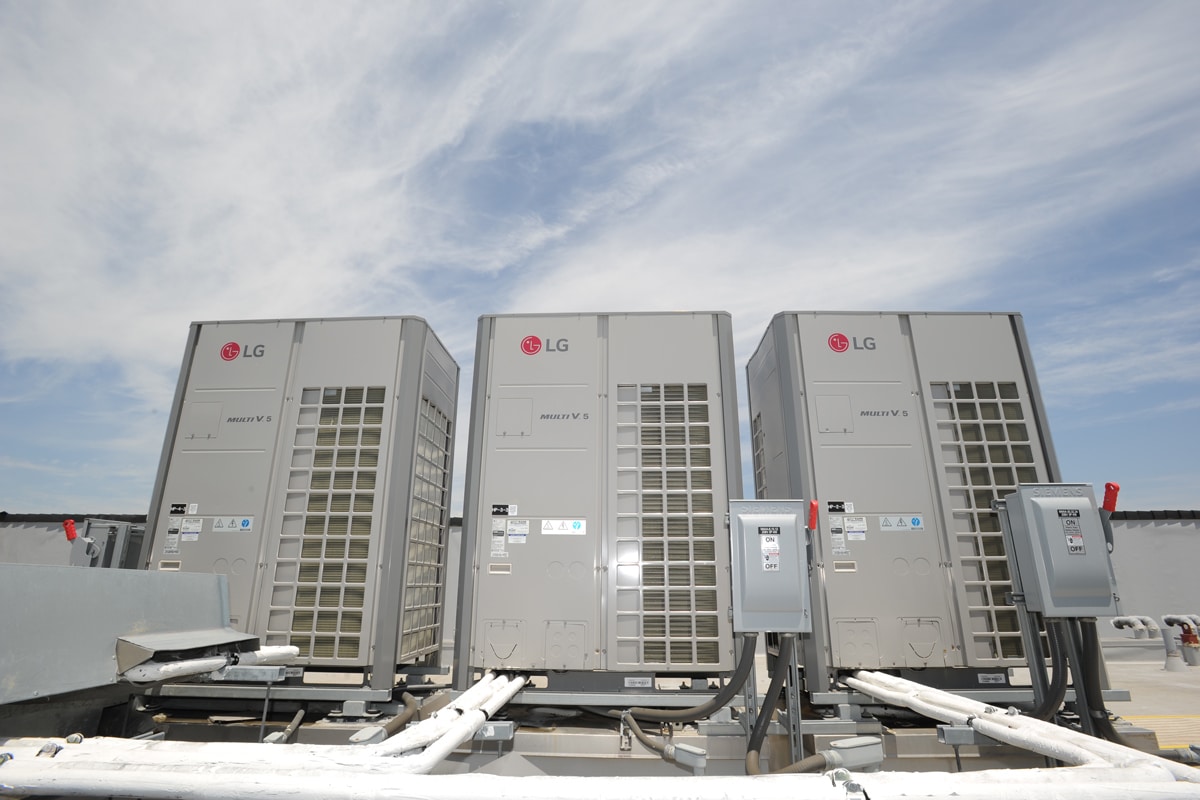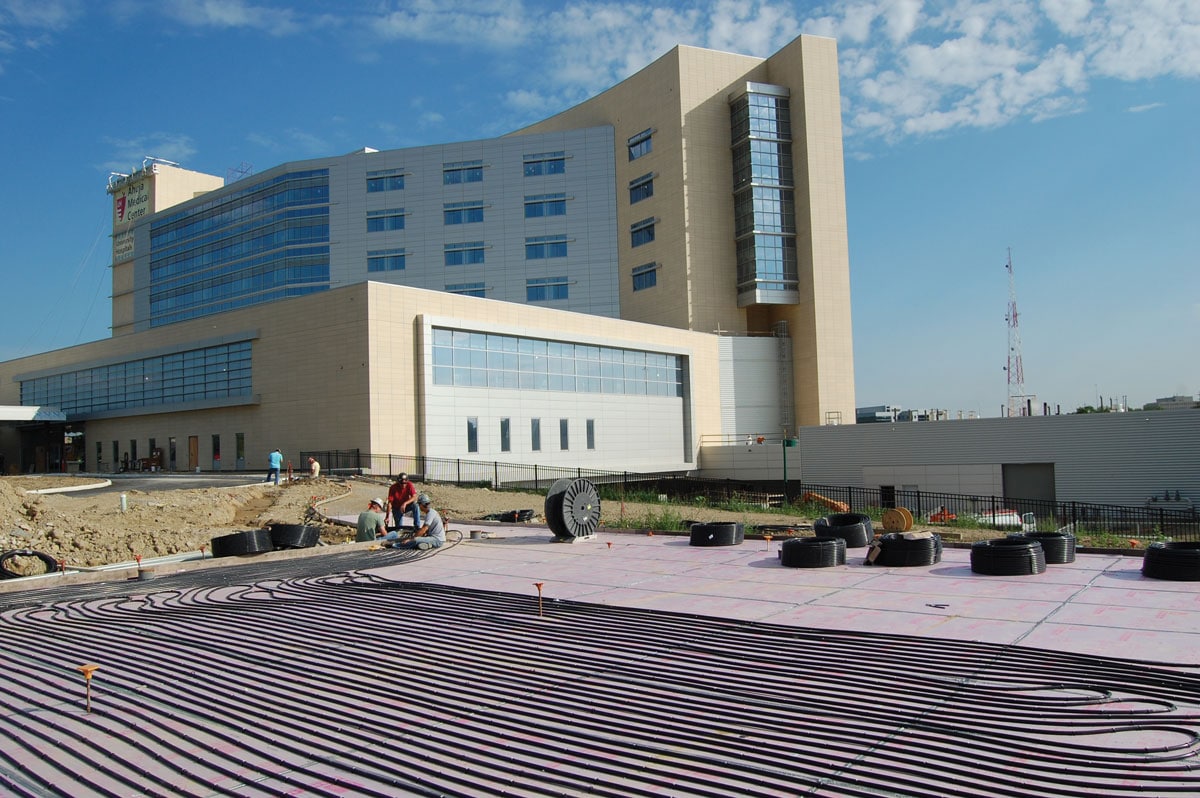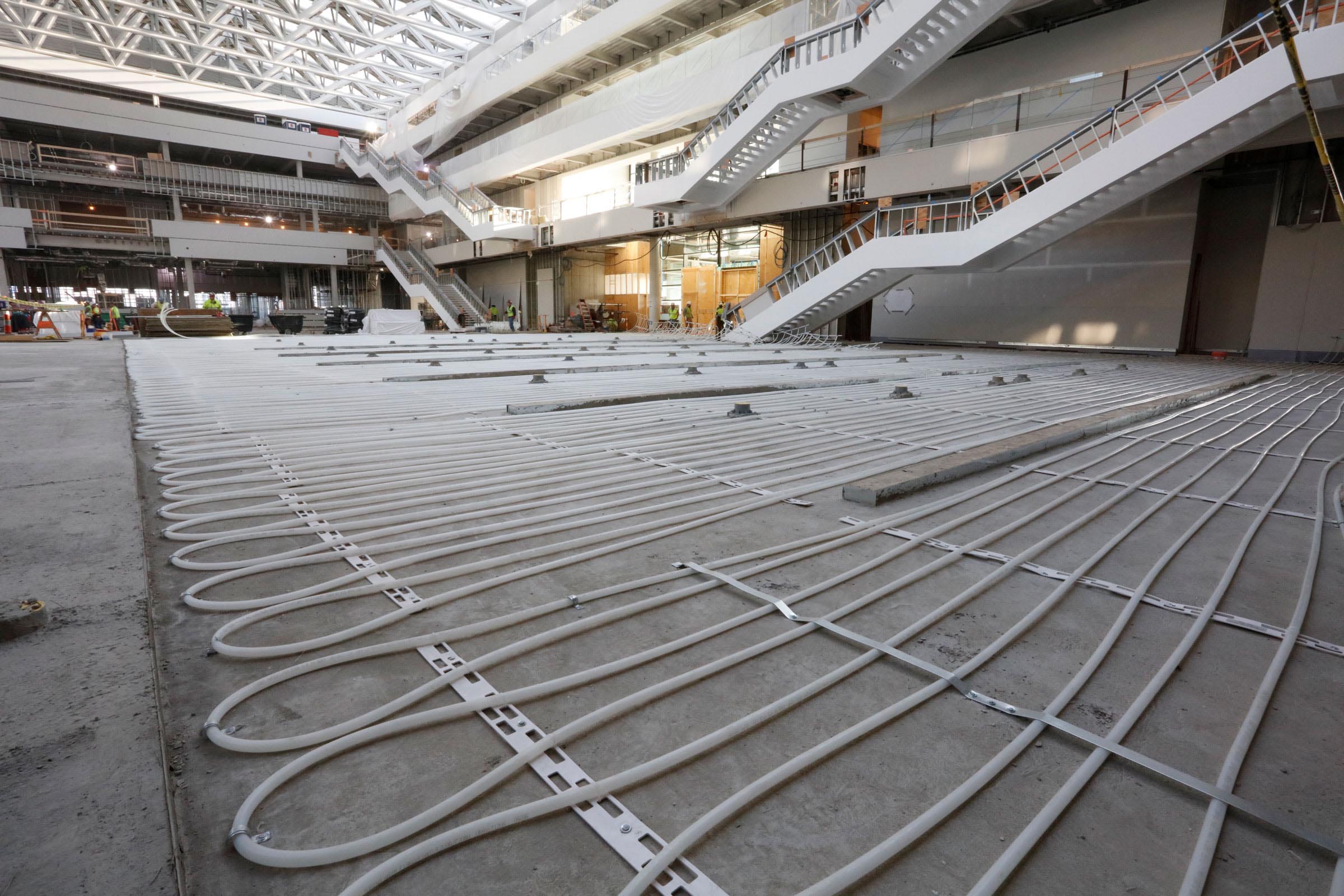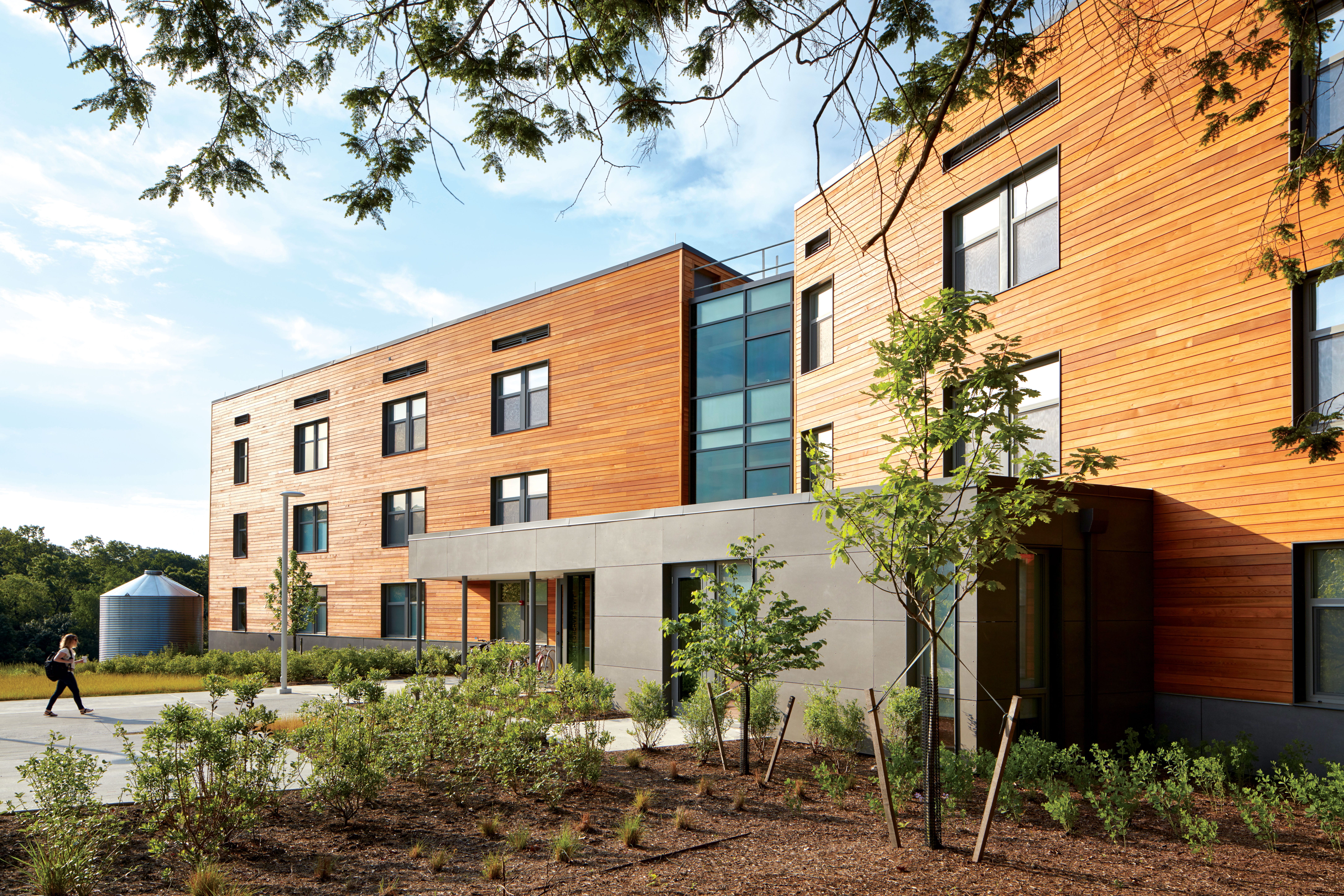Story at a glance:
- Radiant systems offer heating and cooling that is energy-efficient and easy to install.
- Radiant flooring provides considerable design flexibility and warms chilly feet.
- Forced air heating and cooling is integrated and common in homes with existing ductwork.
Between radiant and forced air heating and cooling, there are a world of differences—and the decision between the two is of great importance to both the comfort and the sustainability of a project. According to the US Department of Energy, “Heating your home uses more energy and costs more money than any other system in your home—typically making up about 42% of your utility bill.”
Because it is such an important part of the home but simultaneously one of the most expensive, finding the right heating and cooling system for your project is extremely important. After all, the utility bill reflects not only the financial costs of an imperfect system but also the environmental cost of high consumption.
In the radiant heat vs forced air debate, besides the decision of which fuel to generate heat, radiant and forced air systems each have their pros and cons. Although the space will be warm at the end of the day either way, a lot must go into deciding between the two.
What is Forced Air?

VRF HVAC systems incorporate air filters and exacting settings for air flow and temperature control. Photo courtesy of LG VRF
Forced air systems use ducts to transport and blow heated or cooled air into a space. Forced air systems can integrate both heating and cooling in one mechanism and are amongst the most common forms of heating and cooling in the United States. Buildings with central heat and existing duct systems often use forced air.
Forced air systems are a bit notorious for heating spaces unevenly and noisily, and the ducts take up a substantial amount of space in a home that could be used differently. But, forced air systems have undergone plenty of innovation over the years, and the newest technologies, including variable refrigerant flow, offer impressive precision in temperature control and energy cost reductions. Some systems even operate nearly silently.
As long as the air filters are changed frequently and the system does not rely extensively on recycled air, forced air heating and cooling can improve indoor air quality. The systems promote air circulation throughout homes and commercial spaces.
Pros of Forced Air Systems
- Speed. Forced air systems heat and distribute air throughout an interior space much faster than radiant heating and cooling systems.
- Affordable. Forced air systems are not as expensive as radiant heating and cooling systems and have lower installation costs.
- Easy installation. Most forced air systems are compatible with existing ductwork, reducing installation times and saving money.
Cons of Forced Air Systems
- Not as energy-efficient. Forced air systems are by no means inefficient, but they aren’t as energy-efficient as radiant heating and cooling systems.
- Can contribute to poor air quality. Because forced air systems use, well, air to heat and cool a space, they also unintentionally circulate dust, dander, and other allergens as they operate; this can be mitigated in part by the use of high-efficiency filters.
- Noisy. Regardless of how well-built a forced air system is, it is going to make noise as a result of pushing air through ducts that have built up pressure, something some occupants may find annoying or distracting.
Best Uses for Forced Air Systems
Forced air systems have long been used to heat both residential and commercial spaces, although commercial buildings in particular may make effective use of forced air systems to heat a large or multiroom space all at once, at a lower installation cost than radiant systems.
Forced air systems are especially well-suited to renovations and retrofits as they can make use of existing ductwork—such as that used for a furnace or air-conditioning—instead of requiring all new hardware be installed.
What is Radiant Heating?

Radiant heating systems use electromagnetic waves to transmit heat. When the waves are intercepted by something, be it an object or a person, they are absorbed and converted into heat. Photo courtesy of Viega
Radiant heating systems supply heat directly to surfaces in the home—wall, floor, or ceiling panels. Generally, electricity, hot water, or air make direct contact with the system’s surface and infrared radiation delivers the heat to the air and occupants of the room to warm up the space.
Because radiant systems use contact to transfer heat, they do not disrupt allergens in the home the way forced air can. Plus, the lack of forced air system means radiant heating and cooling requires a dedicated outside air system. This means they cut out all recirculated air that would come from forced air systems and lead to better indoor air quality and healthier spaces. Often radiant systems are healthier, particularly for sensitive individuals.
Radiant heating systems are typically installed as individual zones, each of which is designed to heat a specific area in a building and is controlled by its own thermostat. “Not only does this provide custom comfort control when people are in a space, it also makes the system even more energy-efficient because people can keep the heat low in spaces that are not in use,” Kim Bliss, content development manager at Uponor, previously wrote for gb&d.
There are two main categories of radiant heating, defined by the medium with which they use to radiate heat throughout a space: electric and hydronic.
Electric
An electric radiant heating system typically consists of either electric heating cables embedded in the floor or electrical matting mounted on the subfloor below the actual flooring.
Electric radiant heating systems are most effective when paired with a high thermal mass material, such as concrete, as such materials will store heat for long periods of time after the system is shut off. This ultimately results in reduced energy consumption and lower operating costs.
Pros of Electric Radiant Heating
- Retain heat for a long time. Though they take longer to heat up than forced air systems, electric radiant heating systems also retain that heat for longer periods of time.
- Unobtrusive. Electric radiant heating systems are extremely unobtrusive and may be installed in floors, ceilings, and even walls; even when running, these systems can be almost imperceptible.
- Low maintenance. Once installed, electric radiant heating systems are practically maintenance-free.
Cons of Electric Radiant Heating
- High upfront costs. Electric radiant heating has higher upfront costs than forced air, both in terms of the system itself and installation.
- Less efficient. While they are more efficient than forced air systems, electric radiant systems are not as energy-efficient as hydronic radiant systems.
Hydronic

Hydronic radiant floor systems not only promote cleaner indoor air, but also boast a higher energy efficiency than standard air heating systems. Photo courtesy of Uponor
Hydronic radiant heating systems, on the other hand, circulate heated water—or a mixture of water and antifreeze—through a closed-loop network of pipes laid underneath flooring.
“Water has the capacity to transport energy 3,500 times greater than air,” writes Bliss. “That means a hydronic radiant heating system that uses water to heat a space rather than air will be much more energy-efficient.” The water in hydronic radiant systems may be heated either by a boiler or heat pumps, with the most sustainable options being electric boilers/heat pumps and geothermal heat pumps.
While traditionally copper pipes embedded in concrete would be used in hydronic radiant systems, PEX pipes now offer a more reliable and sustainable option. PEX piping is extremely durable, is rust- and corrosion-resistant, and has an operational lifespan of approximately 100 years, greatly reducing the need for costly resource-intensive repairs and replacement work.
PEX pipes are also incredibly flexible, a trait that allows them to bend around corners without the aid of connector pieces. “This reduces materials inside a building while also improving water flow and reducing pressure loss for better system efficiency and performance,” Devin Abellon, business development manager for engineering services at Uponor North America, previously wrote for gb&dPRO.
Pros of Hydronic Radiant Heating
- Incredibly efficient. Because water conducts heat better than air, hydronic radiant heating is much more energy-efficient than forced air systems, resulting in lower energy consumption and fewer emissions.
- Quiet. Unlike forced air systems, radiant heating systems operate without noise, making them ideal for use in homes and other quiet spaces.
- Healthy. Because they do not circulate air, hydronic radiant heating systems are not capable of blowing dust, dirt, dander, and other allergens around as they operate, resulting in higher indoor air quality and a healthier living environment.
Cons of Hydronic Radiant Heating
- Higher upfront costs. Although operating costs are very small, particularly for installation throughout a home or commercial building, radiant heating can be expensive.
- Requires professional installation. While it’s true that all heating systems should be installed by professionals, this is especially true of radiant heating systems, as improper installation can result in cold spots and uneven heat distribution throughout a building.
- Longer heating times. Despite being able to transport energy better than air, water nevertheless takes longer to heat up.
- Can be difficult to repair. In the event that a pipe bursts or begins to leak, hydronic radiant heating systems can be extremely difficult and costly to repair.
Best Uses for Radiant Heating
Radiant heating systems can be installed in floors, ceilings, and walls so seamlessly as to be easily overlooked, making them an extremely versatile option. Radiant heating is especially well-suited to residential use and is one of the most cost-effective ways to heat a home, as well as one of the most comfortable.
This is because radiant heating systems more closely align with the human body’s ideal heating curve. “Radiant is more comfortable. And human comfort is about 60% defined by the amount of radiant heat transferred, where the remainder is convective, evaporative, respiratory, and conduction in very small amounts,” Adam Botts, product manager at Viega, previously told gb&d. “That radiant heat transfer is what actually makes us feel comfortable.” Radiant heating allows occupants to feel warmer and more comfortable at a lower temperature, resulting in greater energy savings.
Another reason radiant heating is ideal for home use is that it is installed in zones with separate thermostats, giving individuals greater control over their environments and accommodating different temperature preferences.
What is Radiant Cooling?

Installation of the Ray Magic system, which uses radiant gypsum panels to cool and heat rooms. Courtesy of Messana
Just as radiant heating uses contact to contribute heat to make spaces cozy, radiant cooling uses contact to remove heat from spaces and chill them. Pipes and panels pump with cold water, which slowly yet surely neutralizes the heat in the space.
Just like radiant heating, radiant cooling is also significantly more energy-efficient than forced air systems. And, in hot summer months, that energy benefit is even more pronounced as air conditioners notoriously demand an exorbitant amount of energy. “If we want to save energy and reduce our carbon footprint, that’s where we need to focus—reducing the energy consumption in the HVAC device in summer,” Alessandro Arnulfo, cofounder of Messana, previously told gb&d.
A common concern regarding radiant cooling systems is their ability to function in different climates, particularly humid ones, as such conditions could lead to condensation in the event that the surface temperature is equal to or below the dew point. This is, however, an increasingly outdated concern that can be eliminated by the installation of a dehumidifier or dedicated outdoor air system (DOAS).
“Radiant works really almost anywhere a standard forced air system will work,” says Botts. “Existing building control systems dehumidify the ventilation air to the point that a space never reaches the dew point but remains comfortable for occupants.”
Pros of Radiant Cooling
- Energy efficient. Most radiant cooling systems operate 30% more efficiently than traditional cooling systems and can help save up to 50% of the energy consumption in medium-sized buildings when paired with a DOAS.
- Quiet. Air conditioning units and conventional HVAC systems are notoriously loud when in operation, but radiant cooling systems produce zero noise, making for a distraction-free environment.
- Smaller footprint. Radiant cooling systems do not take up as much room as ductwork and as such allow for a larger space between the floor and ceiling, increasing architectural freedom.
Cons of Radiant Cooling
- Requires separate ventilation. Unlike forced air systems, radiant cooling units are not capable of addressing a building’s ventilation needs and require the installation of a separate system, such as a DOAS, to effectively circulate interior air.
- High upfront costs. Like any radiant system, the cost of purchasing and installing a radiant cooling system tends to be higher than forced air systems; in most cases, however, these higher upfront costs are balanced out by the energy savings that come with radiant cooling.
- Not ideal for retrofitting. Because their installation requires that the existing floor or ceiling be removed, radiant cooling systems are not ideal for retrofit projects and are best suited to new construction.
Best Uses for Radiant Cooling
From a technical standpoint radiant cooling works best when installed in buildings with extremely airtight envelopes and ample insulation, especially those located in hot, dry climates with low ambient moisture.
Having dispelled the myth that radiant cooling systems are poorly suited to humid climates, however, there are no real geographic limitations regarding their installation. Projects in certain climes may require the inclusion of a DOAS in addition to a radiant cooling system, but that shouldn’t discourage their usage.
How Does Radiant Flooring Work?

Radiant heating panels in the dorm rooms of Chatham University keep students comfortable year-round and are quiet and hidden, with no disruptive maintenance. Courtesy of Messana
There are two main areas in a building where radiant heating or cooling systems may be installed—the floor or the ceiling, with the former being the most common.
Both radiant heating and cooling systems take up less physical space than forced air systems, making them easy to install under floors, adding only around half an inch of height, depending on the system. Virtually any material can then be placed on top of the radiant system, with no detriment to its effectiveness: tile, carpet, hardwood, or other engineered floorings. “As long as your floor is being removed anyway, it’s a really simple installation,” Botts told gb&d.
Because hot air rises, radiant flooring is especially effective for heating systems as the heat it offers rises and distributes evenly throughout the space. It is among the most popular versions of radiant heating due to its efficiency and lack of visual impact on the design of the space.
Pros of Radiant Flooring
- Energy efficient. Radiant flooring is arguably the most energy efficient radiant heating system.
Uniform heating. Properly installed radiant flooring provides uniform heating throughout a room or building, greatly reducing the likelihood of cold or hot spots forming. - Long-lasting. Radiant flooring systems have an average lifespan of 20+ years before requiring serious maintenance or replacement.
Cons of Radiant Flooring
- High upfront costs. It is more difficult and costly to install radiant flooring in a space that already has flooring. Radiant baseboards or ceilings then become more appealing.
- Elevates floor height. Radiant floors must be installed on top of a subfloor before being covered with the building owner’s flooring of choice; this can cause the floor to raise by as much as an inch, potentially necessitating alterations to doors so that they can clear the new flooring.
Best Uses for Radiant Flooring
Because they are a bit more invasive than radiant ceilings in that they require the existing flooring be pulled up, radiant floors are best suited to new construction and renovations where the original flooring is already going to be removed. Radiant floors are by far the most efficient heating option for residential projects and are commonly installed in bathrooms, bedrooms, and kitchens, though they can be used for whole-home heating as well.
Radiant floors can also be installed in a commercial setting and are especially effective when paired with geothermal heat sources, as this lowers energy consumption even further and reduces operating costs.
How Do Radiant Ceilings Work?

Federal Center South’s atrium has radiant heating in its aluminum ceiling frame, showing off the design flexibility of radiant systems. Photo courtesy of Barcol-Air
Radiant ceilings offer a solution for spaces with restrictive or existing flooring. But they are the same in terms of design flexibility. Even on ceilings, radiant systems don’t impede the visual design of a space.
Radiant ceilings are useful in commercial and educational spaces where quick and easy installation helps get the building up and running fast. The incorporation of a radiant system continues to allow for design flexibility, says Michael O’Rourke, past president of Barcol-Air USA. Radiant panels look and operate just like drywall panels, and therefore can be painted and affixed with lights, molding, sprinklers, or speakers just like a normal ceiling.
Pros of Radiant Ceilings
- Easy installation. Radiant ceilings are very easy to install, especially when compared to radiant floors.
- Supports higher temperature capabilities. Because they do not come into direct contact with occupants, radiant ceilings can support more extreme maximum and minimum temperatures, increasing their effectiveness.
- Less radiant surface required. Because radiant ceilings can support more extreme temperatures, the total radiant surface area can be reduced while still achieving occupant comfort, reducing costs and freeing up space for other ceiling fixtures.
Cons of Radiant Ceilings
- Can be expensive. As with all radiant systems, radiant ceilings tend to have higher upfront costs associated with their materials and installation when compared to forced air heating and cooling systems.
- Can be difficult to repair. If the coils or pipes in a radiant ceiling panel fail, they can be difficult to repair, oftentimes requiring that the entire panel itself be replaced.
Best Uses for Radiant Ceilings
Radiant ceilings—whether used for heating or cooling—are best suited to buildings that do not possess extremely high ceilings, as such conditions could diminish their overall efficacy and nullify their energy savings. Because they are easier to retrofit and are less invasive than radiant floors, radiant ceilings can be very useful additions to existing buildings where intensive renovation or remodeling is not desired.
All in all, creative applications of radiant ceilings can be extremely effective and add rather than detract from the space’s design.
Lark Breen contributed to this article.




